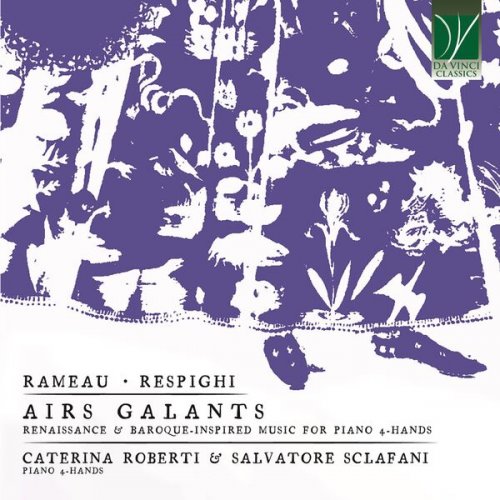Artist:
Caterina Roberti, Salvatore Sclafani, Due di Duo
Title:
Rameau, Respighi: Airs Galants (Renaissance & Baroque-Inspired Music for Piano 4-Hands)
Year Of Release:
2023
Label:
Da Vinci Classics
Genre:
Classical
Quality:
FLAC (tracks)
Total Time: 56:03
Total Size: 214 MB
WebSite:
Album Preview
Tracklist:01. Les Indes Galantes, Airs de Ballet, RCT 44: I. Première Suite: Marche (Transcription for piano 4-hands by Léon Roques)
02. Les Indes Galantes, Airs de Ballet, RCT 44: II. Première Suite: Premier Menuet et Deuxième Menuet (Transcription for piano 4-hands by Léon Roques)
03. Les Indes Galantes, Airs de Ballet, RCT 44: III. Première Suite: Danse des Sauvages – Rondeau (Transcription for piano 4-hands by Léon Roques)
04. Les Indes Galantes, Airs de Ballet, RCT 44: IV. Première Suite: Chaconne (Transcription for piano 4-hands by Léon Roques)
05. Les Indes Galantes, Airs de Ballet, RCT 44: V. Deuxième Suite: Entrée des quatre Nations (Transcription for piano 4-hands by Léon Roques)
06. Les Indes Galantes, Airs de Ballet, RCT 44: VI. Deuxième Suite: Musette – Rondeau (Transcription for piano 4-hands by Léon Roques)
07. Les Indes Galantes, Airs de Ballet, RCT 44: VII. Deuxième Suite: Premier et Deuxième Rigaudon (Transcription for piano 4-hands by Léon Roques)
08. Les Indes Galantes, Airs de Ballet, RCT 44: VIII. Deuxième Suite: Premier et Deuxième Tambourin (Transcription for piano 4-hands by Léon Roques)
09. Les Indes Galantes, Airs de Ballet, RCT 44: IX. Deuxième Suite: Gavotte en Rondeau (Transcription for piano 4-hands by Léon Roques)
10. Antiche Danze ed Arie per Liuto, Suite No. 1, P 116: I. Balletto detto “Il Conte Orlando” (Composer's reduction for piano 4-hands)
11. Antiche Danze ed Arie per Liuto, Suite No. 1, P 116: II. Gagliarda (Composer's reduction for piano 4-hands)
12. Antiche Danze ed Arie per Liuto, Suite No. 1, P 116: III. Villanella (Composer's reduction for piano 4-hands)
13. Antiche Danze ed Arie per Liuto, Suite No. 1, P 116: IV. Passo mezzo e mascherada (Composer's reduction for piano 4-hands)
14. Antiche Danze ed Arie per Liuto, Suite No. 2, P 139: I. Laura soave. Balletto con Gagliarda, Saltarello e Canario (Composer's reduction for piano 4-hands)
15. Antiche Danze ed Arie per Liuto, Suite No. 2, P 139: II. Danza rustica (Composer's reduction for piano 4-hands)
16. Antiche Danze ed Arie per Liuto, Suite No. 2, P 139: III. Campanae parisienses - Aria (Composer's reduction for piano 4-hands)
17. Antiche Danze ed Arie per Liuto, Suite No. 2, P 139: IV. Bergamasca (Composer's reduction for piano 4-hands)
This recording invites to the discovery of Renaissance and Baroque works, transcribed for piano four-hands in different historical periods and according to different aesthetics. On the one hand, the transcription by Léon Roques (1839-1923) of Airs de Ballet from Les Indes Galantes, an opéra-ballet by Jean-Philippe Rameau (1683-1764); on the other hand, the Antiche Danze ed Arie per Liuto (first and second suites) by Ottorino Respighi (1879-1936), freely transcribed from 16th- and 17th-century original pieces for lute. According to the catalogue of Respighi’s works, compiled by Potito Pedarra for Ricordi in 1985, only the first two suites out of the three existing ones were arranged for piano four-hands by the composer himself from their orchestral version and published respectively in 1919 and 1923.
Our predilection for the Renaissance and Baroque repertoire, as well as the performance challenges produced by such ‘ancient’ compositions in their ‘modern’ transcriptions, intrigued and prompted us to engage in an in-depth interpretive research, especially with regard to the specificity of musical writing of the past in relation to current instrumental practices.
The transcriptions by Roques and Respighi are inevitably different in style from the original works that inspired them. We have therefore considered worthwhile to start our work from an analysis of the orchestrations by Rameau and Respighi in order to grasp their spirit and peculiarities: the performance practice of early music has represented a fundamental yardstick for our approach to the Airs de Ballet from Les Indes Galantes and the Antiche Danze ed Arie per Liuto, in the context of the interpretation for piano four-hands.
Originally conceived for Baroque orchestra, the Airs de Ballet are transcribed by Roques in a late Romantic style. Through the distinctive timbre of the piano, Roques gives new life and expressiveness to an ancient taste. Moreover, the artistic trajectory of the French organist and composer is linked to numerous transcriptions, in particular those from Claude Debussy (1862-1918), Maurice Ravel (1875-1937), Richard Wagner (1813-1883) and Jacques Offenbach (1819-1880). In the transcription for piano four-hands of Les Indes Galantes, the skillful use of the broad spectrum of keyboard registers proves particularly effective in rendering the complexity of the orchestral fabric.
In our exploration of the intersection between piano writing and Baroque aesthetics, exchanging views with interpreters and specialists of Rameau’s repertoire has significantly helped us to pursue a historically informed interpretation, coherent with the performance practice of the original version for orchestra of Les Indes Galantes: from the orchestration by Rameau himself to the piano dynamics indicated by Roques, from the phraseological analysis to the ornamentation, our interpretative choices have constantly maintained a balance between the specific characteristics of the piano, for which this transcription is intended, and the philological rendering of the work. Among the various study materials, the modern edition of the work had a relevant role. This edition, based on the August 1735 original version and realized in 2014 by Nicolas Sceaux for the concerts of La Simphonie du Marais and its director Hugo Reyne, also constituted the starting point for the recording of the complete Les Indes Galantes, by the Simphonie itself (2014).
The musicological value of the work by Sceaux, Reyne and La Simphonie du Marais prompted us to take it into account for a comparison with Roques’ transcription. The piano writing, as well as the dynamics and articulations of late Romantic sensibility indicated by the latter, do not always succeed in fully rendering the colours, ornamentations and phrasing of the orchestra. For example, in the Coda of the Chaconne that concludes the first suite of the Airs de Ballet, we decided to play the interventions of the trumpets – present in the original version for orchestra – with repeated notes instead of broken octaves as proposed by Roques. The reason for this choice is our desire to better evoke the timbre, colour and playing technique of the trumpets of Rameau’s time, which are not fully represented, in our opinion, by the sound effect obtained by playing broken octaves, certainly more pertinent to piano technique but less effective.
Following the same logic, we retrieved voices from the original score that were not present in the transcription by Roques, when we considered them important within the polyphonic structure. These and similar changes were motivated by our quest for a piano interpretation as consistent as possible with the instrumentation of Rameau’s baroque orchestra.
Due di Duo’s interpretation of Roques’ transcriptions of Les Indes Galantes could resolve the apparent absence, to date, of an available recording. For this reason and for their rare occurrence in concert programmes, we consider Roques’ suites a precious treasure that deserves to be enhanced. Published by Durand in 1906 and 1908 respectively, under the direction of Camille Saint-Saëns (1835-1921), the suites are part of a monumental work of critical edition of Rameau’s opera omnia, carried out by Saint-Saëns himself from 1894 onwards. Whereas Rameau’s works did not yet feature permanently in early music programmes between the end of the 19th century and the beginning of the 20th century, Saint-Saëns’ contribution was fundamental in ensuring that the art of the great French Baroque composer could be fully recognised in the modern era.
Alongside the transcription for piano four-hands of the Airs de Ballet from Les Indes Galantes, Respighi’s first two suites of the Antiche Danze ed Arie per Liuto reveal the composer’s nostalgic interest for the musical themes of the past and display an intriguing, personal evocation of Renaissance and Baroque sonorities: the original melodies for lute, simple and popular in character, stand out from a background of unexpected harmonisations and refined contrapuntal weaves. Respighi takes lute tablatures from the 16th and 17th centuries up and reworks them, at first for orchestral ensemble, organising them in the form of suites. The focus on an Italian musical tradition, until then neglected, is not to be taken with a philological intent. Highlighting once more his great qualities as an orchestrator, early music becomes, for Respighi, a field of renewed compositional inspiration and exploration on timbre and colour. Compared to Roques’ work, Respighi’s free transcription of pieces of Italian Renaissance and Baroque music and its further reduction for piano four-hands imply a relatively different pianistic approach: in this case, a direct comparison with the original lute versions did not seem so relevant as for the Rameau’s transcription. Nevertheless, listening to and studying these pieces proved invaluable in understanding which practices and styles inspired the Bolognese composer, and in informing our interpretation. Moreover, the comparison with the original version for orchestra generated reflections and led to interpretative choices regarding timbre, sound quality and conducting of the voices.
Both Roques’ transcription and Respighi’s arrangement show a compositional style and pianistic language inevitably ‘other’ then the original pieces of reference. Research and in-depth study of the performance practice of early music have, therefore, led our pianistic gesture and represented, at the same time, a fundamental impulse to enhance the versatility of the instrument in a four-hands duo.
Salvatore Sclafani & Caterina Roberti © 2023


![Soulparlor - Day By Day (2025) [Hi-Res] Soulparlor - Day By Day (2025) [Hi-Res]](https://www.dibpic.com/uploads/posts/2025-11/1762578819_xw0kobyk0sunc_600.jpg)

![Aaron Parks - By All Means (2025) [Hi-Res] Aaron Parks - By All Means (2025) [Hi-Res]](https://www.dibpic.com/uploads/posts/2025-11/1762334967_by0ba50eyhnfc_600.jpg)


![Uros Peric, Big Band RTV Slovenija - Screamin’ Hallelujah (2022) [Hi-Res] Uros Peric, Big Band RTV Slovenija - Screamin’ Hallelujah (2022) [Hi-Res]](https://www.dibpic.com/uploads/posts/2025-11/1762508895_upsh500.jpg)

![James Newton Quartet - Live in Willisau Switzerland 1983 (Live) (2025) [Hi-Res] James Newton Quartet - Live in Willisau Switzerland 1983 (Live) (2025) [Hi-Res]](https://img.israbox.com/img/2025-11/08/89npv9nuxof1eojrn4rfwc596.jpg)
![Rotem Sivan - Heart Thieves (2025) [Hi-Res] Rotem Sivan - Heart Thieves (2025) [Hi-Res]](https://www.dibpic.com/uploads/posts/2025-11/1762586952_wdida7vxsh15a_600.jpg)